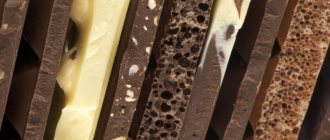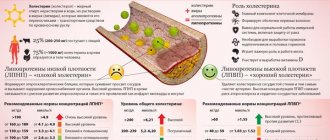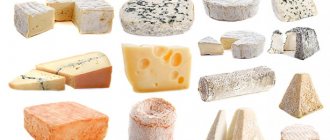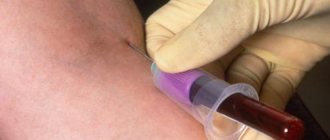Compound
The fats contained in lard give the body a large amount of energy.
The calorie content of the product is 850 kcal per 100 g. The norm for the human body is 1700 kcal. Chemical composition of lard:
- proteins;
- fats;
- carbohydrates;
- ash;
- water;
- vitamins A, PP, NE, E, niacin;
- trace elements iodine, iron, copper;
- macroelements sodium, chlorine, potassium, phosphorus, calcium;
- saturated and unsaturated fatty acids.
Lard contains many biologically active components, which allows you to activate the body’s work and saturate the blood with useful substances.
Harm: why is the product dangerous?
The inclusion of lard in the diet is opposed due to the following negative properties, which the table describes:
| Dangerous product | Bad influence |
| Salty | Tissue swelling due to fluid retention |
| Formation of salts on the walls of blood vessels | |
| Old | Entry of carcinogens into the body |
| Frozen | |
| Smoked | Poisoning with toxic substances |
| Increased risk of gastrointestinal cancer |
To prevent lard and the cholesterol it contains from causing harm, you need to buy a fresh product with a minimum amount of spices. The maximum permissible storage period is 6 months. After this, animal fat loses its beneficial properties and accumulates toxic substances that can increase cholesterol, provoke cancer and worsen the condition of the cardiovascular system. If you are obese, lard can also be hazardous to your health, so you can eat it, but you should consult a nutritionist before including it in your diet.
How much cholesterol is in lard?
The amount of cholesterol in lard ranges from 85-90 mg per 100 g of weight. Despite the fact that the product is considered very harmful and is contraindicated for use in various diseases of the cardiovascular system, its cholesterol level is not the highest. For example, chicken liver contains 700 mg of cholesterol, cheese - 500 mg. The maximum amount of the substance is found in beef kidneys – 1200 mg.
The daily intake of cholesterol for an adult is 300 mg.
Cholesterol in lard: what kind of lard can you eat without increasing cholesterol?
- There is cholesterol in any pork lard! We have already come to the conclusion that it is not as dangerous as it is portrayed, and not in such large quantities. But here it is worth making some reservations. Firstly, only fresh lard is healthy. Old, yellowed lard can accumulate harmful carcinogenic substances. In addition, it causes a jump in cholesterol levels. Old lard is identified by its yellow color and unpleasant odor; we take a maximum of six months for the time period - you cannot store lard, even salted, for longer! It no longer has the same properties, is much worse absorbed and can even cause not only poisoning, but also neoplasms.
- But there is one concern - salt! This is a natural preservative, which extends the shelf life of lard. But it can retain fluid in the body and lead to edema, especially if there are metabolic disorders. As a solution, control your salt intake in other foods. If you have salted lard on the table, then you shouldn’t add it too much, for example, to vegetables.
How to choose?
- When frying lard, substances harmful to the liver are formed, such as triglycerides. And there is nothing good in eating such lard. In addition, during prolonged heat treatment it can also release harmful carcinogenic substances! A similar picture is observed when heating vegetable oil. But this is already a broad problem with all fried foods in general - you should consume it as little as possible. Although it is still better to fry in fat from salted or fresh lard. But here we are talking about comparison with the same vegetable or butter, the melting point of which is much higher. This means that much less nutrients are retained in it.
- But a small piece of lard with vegetables, rye bread or crispbread will be a very useful addition to the diet. Ideally, give preference to products with coarse fibers. They further reduce cholesterol levels.
As you can see, the cholesterol in lard is highly exaggerated. Firstly, there is not so much of it, and secondly, we have already seen that this product, when used in moderation and correctly, is of great benefit! But this point also applies to any product - after all, excessive consumption of anything can be harmful.
Does it increase cholesterol?
Cholesterol is a substance that the body needs for the full functioning of its organ systems. If the level of this substance is insufficient, the liver is responsible for replenishing it. If the level of cholesterol in the blood is significantly exceeded, a mechanism is launched to remove the excess substance and cleanse the blood.
Lard increases cholesterol only when consumed in excess. If the patient does not abuse foods containing fat, then the product will only help eliminate excess cholesterol in the blood.
Cholesterol in lard: is it possible to eat lard if you have high blood cholesterol?
As we have already concluded, the cholesterol in lard is not that dangerous. But still, you shouldn’t abuse it!
- In general, fats of animal origin are necessary for the normal functioning of the body; they contain substances that do not enter the body with fats of plant origin. Based on the above, we conclude that moderate consumption of lard is not only not harmful to the body, but is even extremely beneficial! The only limitation is that those who have liver diseases, stomach diseases and excess weight should still be careful. People over 60 years of age should also use it with caution and limit this product to children under 3 years of age!
- As an example, for a jump in blood cholesterol to occur, you need to eat about half a kilogram of such a fatty product at a time. And this is already dangerous for digestion, and in general even avid lard lovers cannot handle such a share!
Important: Pork lard also has an effect on cancer, suppressing cancer cells and acting as a preventive measure against their development. Therefore, this product is extremely useful for people living near radioactive sites to use on an ongoing basis.
But it’s still better not to get carried away with lard skins. Especially if it has stubble! After all, it can lead to illnesses and inflammation of the gastrointestinal tract. Also, the skin contains a lot of all the vitamins of the product, but also chitin, which is extremely difficult to digest. And if the pig was also fed harmful or chemical feed, then this entire mixture will be mainly concentrated in the skin!
We distinguish
Can it be consumed if you have high cholesterol?
Is it possible to eat lard if you have high cholesterol? It is possible, but you need to limit the amount of product - no more than 30 g per day.
If cholesterol comes from food, the liver stops its own production of the substance, which helps prevent the formation of excess cholesterol.
You should not eat lard if you have cholesterol only if you have severe metabolic pathologies.
When consuming lard, it is worth considering various sauces and sausages, which also contain a certain amount of the product.
How to eat lard correctly
A small piece of salted bacon, eaten half an hour before the main course, creates a feeling of fullness for a long time. Lard is an excellent source of energy; it does not contain indigestible substances, which means it does not burden the digestive tract. It can be considered a dietary product.
It is better to eat lard with whole grain or bran bread. You can combine it with vegetables, for example, eat it with cabbage or prepare a dietary hodgepodge.
Beneficial features
Lard has a lot of useful substances. Regular consumption has a positive effect on the body:
- Prevention of diseases of the cardiovascular system. Due to the content of amino acids and vitamin composition. In terms of usefulness, lard is equal to fatty fish.
- Saturating the body with energy. The fatty composition of the product allows you to provide the body with a large amount of energy. When broken down, fats can increase a person’s performance, give them strength and vigor.
- Eliminates joint pain. In folk medicine, lard is used as a warming ointment, which is applied to the joint at night.
- Can give a feeling of satiety. The product is popular when following a diet. If a person does not want to overeat during lunch, then half an hour before meals you need to eat a small piece of lard.
- Restoring immunity. The selenium content in the product helps strengthen the body's protective properties.
- Medicine for mastitis, burns, toothache. Those who adhere to treatment with traditional medicine are familiar with the healing properties of lard. For the listed ailments, a piece of lard, previously cleared of spices and salt, is applied to the sore spot.
Consuming lard within normal limits helps regulate blood cholesterol levels. It is recommended to control the amount of fat eaten to avoid metabolic disorders and the development of cholesterol diseases. The product is useful only with moderate consumption.
Useful material
Pork lard contains beneficial substances that cannot be found in many food products.
The component in the product is arachidonic acid.
This acid takes an active part in many metabolic processes in the body, and also participates in many reactions in the synthesis of many molecules. The benefits of arachidonic acid for the body cannot be exaggerated, because it is a truly valuable product.
The acid takes part in the synthesis of many hormones (including sex hormones), as well as in the synthesis of cholesterol molecules and lipid metabolism. Every patient with high blood cholesterol needs to know how lard affects cholesterol.
Lard has a positive effect on the body because arachidonic acid is found in the myocardial enzyme and in acids such as linolenic, oleic and palmitic.
These acids help cleanse the myocardium and bloodstream from bad cholesterol molecules.
B vitamins, as well as vitamin D and E; lard contains carotene and vitamin A.
The participation of such vitamins in the body is undeniable - they take an active part in activating the immune system and also strengthen the vascular membranes. Lard prevents the development of cancer in humans.
An important property of lard is its long shelf life.
All meat products have the ability to spoil very quickly; only one product can be stored for a long time - bacon. This factor allows you to stock it for future use and store it fresh in the freezer, or salted in the refrigerator.
The bioavailability of lard is 4 - 5 times higher than the bioavailability of butter.
If during pregnancy a woman has deviations from the normative indicators of the level of cholesterol in her blood, then the use of bacon should be reduced to a minimum, or its use should be abandoned altogether for this period.
The consumption of bacon should be minimized if during pregnancy a woman has deviations from the normative indicators of cholesterol levels in the blood.
Harmful properties
Selenium in lard strengthens the body's immunity
The negative effects of lard are as follows:
- Edema formation. The salt contained in lard retains fluid in the body, which can cause swelling. If your diet does not contain foods with a lot of salt, then lard will not harm the body.
- Carcinogens. Harmful substances are contained only in old lard. It is necessary to control the shelf life of the product to avoid negative effects on the body. If lard has been stored for more than 6 months, it begins to accumulate carcinogens.
- Harmful substances. Contained only in smoked lard. It is known that if the product is smoked, most of the beneficial properties are lost. Lard takes on the quality of junk food and contributes to the development of cancer of the gastrointestinal tract.
To avoid harmful effects on the body, it is recommended to eat only fresh lard with a low salt content. Smoked lard is not at all suitable for treating cholesterol.
Composition, benefits and harms of lard
Animal fats are important for the proper functioning of the body. The optimal amount of fat from food is considered to be about 70 grams, of which 2/3 comes from animal fats. Until recently, it was generally accepted that lard was quite harmful to health, but new research has proven the opposite. Regular pork fat has a large number of beneficial properties .
- A large amount of vitamins. Namely vitamins A, F, D, E , B
- Lanolin, palmitic, oleic fatty acids in high concentrations, the content of which makes lard equivalent to olive oil and fatty fish, which is so healthy and beloved by nutritionists. Thanks to this, daily consumption of lard helps reduce bad cholesterol , and is also a good prevention of vein diseases.
- Due to the high content of selenium, this fat can strengthen the immune system .
- Arachidonic acid is an important part of the heart muscle enzyme and plays a significant role in regulating hormonal levels and strengthening the immune system. It is noteworthy that so far this substance has not been found in any other product except the one mentioned above.
- Since lard is pure animal fat that has retained all its bioactive components, when broken down in the stomach it releases a large amount of energy . Even a small piece of it will help you quickly fill up and not feel hungry for a long time, and will also help you warm up and gain strength before the upcoming physical activity.
- Despite the previous fact, this is a dietary product , albeit very high in calories. This is due to the fact that lard is easily digested, without lingering in the stomach and without creating a rotting process, so it can be indicated even for intestinal dysfunction, as well as when you simply need to reduce the load on the digestive organs.
- Allows you to forget about the feeling of hunger for a long time. Surprisingly, people trying to lose weight are advised to eat a small piece of lard 30-40 minutes before meals; this will prevent them from overeating, which means limiting the amount of cholesterol they get from food.
- It is also the only animal product that can be stored for a long time . With the help of ordinary table salt, the shelf life of lard is extended to several months, so lard is an indispensable product on hikes and long trips.
- A simple and quick snack . Despite the fact that it takes a lot of time to salt lard and wait until the salt and spices soak it thoroughly, this work is bought very quickly. Subsequently, you just need to put a piece of lard on the bread and a simple snack is ready.
- For many centuries, fat has been used not only as a tasty and healthy food, but also as medicine . You can rub it on the affected areas of the skin, you can make compresses with it, both in pure form and in combination with other products, and due to its enveloping properties, corned beef has become an indispensable part of most feasts, as it helps you not get drunk longer.
- The cholesterol content in lard does not harm the body , since it is neutralized by other components that are contained in it, but it also prevents the formation of excess, bad cholesterol by blocking its synthesis in the body.
Despite all the benefits of bacon, it is still worth remembering that this product also has harmful properties . This is primarily due to the large amount of salt, which is used as a preservative to extend the shelf life of the product. Sodium in salt has the ability to retain excess moisture in the body, thereby causing edema. This is especially dangerous for people who already have metabolic problems.
You should also stop eating old fat . After lying in the refrigerator for more than 6 months, lard will not only lose its taste, but also ceases to be absorbed by the body and begins to accumulate carcinogens. It is better to throw away the stale piece and not risk your health.
In addition, it is worth limiting the consumption of smoked lard . Firstly, this type of processing of the product kills some of the vitamins, and secondly, during the smoking process certain substances are formed, which, when accumulated in the body, provoke the development of cancer.
Summing up the benefits and harms of lard, we can safely say that there are many more beneficial qualities, and they more than cover the possible harm. Even nutritionists do not recommend completely excluding this product from your diet, because a healthy and balanced diet should include a variety of foods. Complete exclusion of any product will not bring positive results, so you should not deny yourself pleasure, especially if you follow moderation in everything.
How to choose quality lard
In order not to suffer from a low-quality product, it is recommended to adhere to the following indicators when choosing lard:
- To prevent the smell of urea from the lard of wild boars, the animal must be castrated in time. To avoid buying lard with an unpleasant odor, you need to heat it with a lighter before purchasing. The test will allow you to purchase lard from a castrated boar or pig.
- It is recommended to buy lard from a domestic manufacturer. This particular product has a high degree of quality. To distinguish imported lard from domestic lard, you need to pay attention to the condition of the skin. Local producers process the lard using a blowtorch, which leaves behind a small amount of bristles. Imported lard always has a smooth skin.
- You cannot buy lard with a pink tint and a loose consistency. This is the first indicator of possible infectious damage to the product.
Another indicator of fresh lard is the presence of shine on the skin and the product itself. If there is no shine, then the lard has most likely been stored for a long time and is overdried. Useful substances in such a product are in minimal quantities.
How to choose?
In order for lard to bring maximum benefits to the body and not cause many ailments after taking it, you must follow some rules when choosing lard:
- You need to buy this product from trusted sellers, or in designated places. Request from the seller a certificate of compliance of the goods with quality criteria;
- You need to ask the seller for a knife. The knife for cutting lard should be separate, and not the one used to cut meat. Using a knife on lard can introduce helminths, as well as a large variety of bacteria;
- Scratch the fat from the skin itself with the blunt side of the knife. It should be scraped off in small grains. This is confirmation that the pig was not fed dietary supplements and antibiotics to quickly gain weight, and the pig had normal nutrition and the lard had time to ripen during the fattening period. This is a sign of a quality product;
- You also need to smell the bacon. A fresh product always smells like fresh meat. You just need to choose smoked lard based on other rules, because the quality of such lard is difficult to determine by smell, the same applies to ready-made lard, which is prepared by boiling with spices, or by salting in a saline solution with the addition of fragrant spices - bay leaves , allspice, thyme, cloves;
- High-quality fresh lard is white or slightly pink in color. If the lard has a greenish or yellowish tint, then this indicates that the lard is quite old and was not stored correctly. Buying such a product is dangerous, because it will not only increase the concentration of cholesterol in the blood, but can also lead to poisoning of the body by bacteria, which during this time have become happy in the stale bacon;
- When choosing smoked lard, in order to determine the method of smoking it - a natural method, or a method using liquid smoke, it is necessary to scrape the skin on the smoked lard. If the smoking method is natural, then after the brown layer of skin there is a white layer. When liquid smoke is used in processing, it colors all the fat evenly and its skin too. Eating such bacon is dangerous for the body, because it has many carcinogens and chemical compounds;
- The consistency of the bacon should be dense, and the color should be uniform. Lard can be with or without meat streaks.
Only fresh and natural lard can give a person pleasure from its consumption, as well as have a beneficial effect on the body and not increase cholesterol in the blood, but rather normalize the synthesis of lipid molecules.
Only fresh and natural lard can give a person pleasure from its consumption.
So is it good or bad?
So, lard is a controversial product with a high cholesterol content. It clearly has more useful qualities, and this must be used skillfully. Any product can become bad from a dietary point of view, but even nutritionists do not agree that lard should be excluded from the human diet. The benefits that this product will bring will more than cover all its few shortcomings. Finally, we must not forget about the taste and pleasure that this product provides. Strict prohibitive measures never lead to positive results. It is much easier to enjoy life, gain energy and restore your strength with the help of such a wonderful product - salted lard. But high cholesterol needs to be dealt with by completely different methods and only after consultation with a specialist.
The benefits of lard for the body
Don’t forget about the beneficial properties of pork fat, because it contains not only vitamins (E, A and D), but also arachidonic acid. This substance is able to regulate cell activity, normalize hormonal balance and effectively cleanse the walls of blood vessels from lipoprotein deposits.
Since ancient times, lard has been widely used in folk medicine as a cure for various diseases. Benefits have been proven for both internal and external use.
A compress of rendered pork fat quickly relieves joint pain, and damage to ligaments and bones after injuries (fractures) is well eliminated by rubbing the sore spot with a mixture of fat and salt. In addition, pork fat is excellent for relieving toothache, curing eczema and mastitis.
New research on fat and cholesterol
Pork lard is a favorite product for many; it is eaten raw, added to soups and main courses, and used to fry scrambled eggs and potatoes. All this is undoubtedly very tasty. But those who have heard about cholesterol, its deposits on the walls of blood vessels and the consequences to which this leads, always feel some remorse when enjoying this far from dietary product. Of course, lard is pure animal fat. This means it is a source of that very harmful cholesterol that leads to atherosclerosis and many other troubles. What do the new studies say?
No one will deny that lard contains cholesterol. But is there really so much of it in comparison with other cholesterol-containing products and is it so harmful? Is it necessary to give up lard for those who have already detected an increase in cholesterol? And how are the consumption of lard and lipid metabolism in the human body related? Does it affect cholesterol levels?
How to take a blood test?
To determine the concentration of the substance, a biochemical blood test is prescribed. The test determines the level of bad, good and total cholesterol, as well as the concentration of other lipid substances.
The level of cholesterol in the blood of women after 40 years, as in other age groups, can change under the influence of many factors. Therefore, in order to eliminate the possibility of a diagnostic error, it is necessary to properly prepare for the test.
A few days before taking a blood test, you need to give up alcoholic beverages, reduce the amount of fatty and fried foods, but do not radically change your diet. The day before donating blood, it is necessary to avoid active sports.
There is a home test to determine the concentration of this substance, but to carry it out, blood is taken from a finger, so such an analysis is less accurate and informative, unlike a biochemical study. The use of home tests will help people who are undergoing therapy to adjust their cholesterol levels and need to constantly monitor changes in their levels.
Fat metabolism
It cannot be said that lard consists entirely of bad cholesterol. If we compare it with other products, it will become clear that lard contains the same amount of it as veal, beef, hard cheese, and fatty fish, which have always been considered healthy products. There is much more cholesterol in butter, kidneys, yolks, and cream cakes. Cholesterol, which is part of lard, plays a significant role in lipid and energy metabolism. It is necessary for the formation of the following compounds and structures:
- steroid hormones;
- structural units of the cell membrane;
- bile acids;
- vitamin D
Cholesterol is especially needed for a growing child's body. Its deficiency can cause frequent infectious diseases, growth retardation and mental development. It is quite natural that cholesterol levels in pregnant women are slightly higher than normal.
Not much of this substance enters the body with food - only about 20%. The rest of the cholesterol is continuously synthesized by the cells of the liver and small intestine. If fatty foods are completely excluded from the diet, the body will launch compensatory processes and begin to intensively produce a lot of cholesterol, and at the first opportunity, store fat in reserve in the form of extra pounds.
The liver of a healthy person regulates the required amount of cholesterol itself.
A fifth of the formed cholesterol is excreted in feces, and the rest is reabsorbed into the body and is included in the hepatic-intestinal circulation cycle. The daily intake of cholesterol into the body should not exceed 500 mg. To break this norm, you need to eat more than 500 g of lard daily, which is hardly possible even for lovers of this product.
How to lower levels without pills - diet and lifestyle
Methods for reducing cholesterol concentrations are selected depending on how critical the deviation from the norm is. If the concentration does not greatly exceed the norm, the risks of developing diseases/pathologies of the heart and blood vessels are minimal; a dietary menu for high cholesterol will help normalize the health status.
A diet for high cholesterol in women over 40 years of age excludes the following foods:
- butter;
- fatty meats;
- salo;
- chicken yolk;
- dairy and fermented milk products with a high percentage of fat;
- fast food;
- snacks - chips, crackers;
- sweets and confectionery;
- coffee;
- salt and spices, herbs;
- sauces.
The basis of the diet is cereals, lean fish and lean meat. All products should only be boiled, baked or steamed. Vegetables are recommended to be consumed raw or subjected to mild heat treatment.
Not only diet, but also the mode of eating plays an important role. You can’t overeat, but it’s also forbidden to bring yourself to the point of fainting from hunger. Therefore, meals should be fractional - eat food in small portions, up to 5 times a day.
There are foods that can reduce the concentration of bad cholesterol in the blood, so it is recommended to include them in your daily diet. These products include bananas and kiwi, lemon, flax oil and garlic.
To normalize the amount of lipid substances, preventing the development of complications, it is necessary to reconsider your entire lifestyle. Regular and moderate physical activity, adequate sleep and rest are needed. If you follow all your doctor’s recommendations, you can lower your cholesterol without taking medications.
Materials used in the article:
https://holester.ru/diety-i-pitanie/mozhno-li-est-salo-pri-povyshennom-holesterine.html
https://perelomu.net/40/norma-xolesterina-v-krovi-u-zhenshhin -postle-40-50-i-60-let-tablica.html
https://giperton.com/salo-pri-davlenii.html
Post Views: 211
What is lard?
Lard is a natural product containing fat of animal origin. However, calling it simply a fatty ingredient is not entirely correct, since lard is a natural subcutaneous layer in which tissue cells and biological active substances are present. According to explanatory dictionaries, lard is the name given to hard fat that accumulates under the skin of an animal as a result of its fattening. The functionality of the sebaceous layer in the animal’s body is explained by the cumulative reserve of triglycerides and saturated fatty acid substances in case of unfavorable conditions and lack of food.
If for an animal it is an emergency supply, then for a person this product is a delicacy, a tasty dish or high-calorie food for restoring vital energy and physical strength. Lard is recognized in the cuisines of European and Slavic peoples; it is very popular due to its high calorie content and ease of preparation.
Let's try to understand how sebaceous products affect the human body, in particular, whether there is a relationship between lard and cholesterolemia.
Choosing good lard
Since lard is most often consumed raw, without any heat treatment, special attention should be paid to choosing a quality product. To do this, experts recommend paying attention to its color, smell, taste, and overall appearance.
- Uncastrated boar lard is different from pig lard. Such fat will have an unpleasant smell of urea, which, however, is only noticeable when heated, so when going to the market, keep a box of matches with you.
- Due to the high density of fibers, there is no place for infection to develop, with the exception of pink fat (this is observed if the animal was not bled sufficiently during slaughter) and if there are veins of meat, so Trichinella can multiply in it, which does not die even when salted and frozen .
- The best option would be to make a purchase where all products are approved by veterinary sanitary examination . To confirm this, a corresponding seal is placed on the skin.
- When choosing imported fat, be prepared for the fact that the pigs were raised on hormonal drugs . It is better to give preference to a domestic manufacturer, in which case there is also a higher probability of buying the freshest product. You can safely take a thick piece from farmers.
- Try to buy only fresh, snow-white lard and salt it at home yourself, as unscrupulous manufacturers often disguise old yellowed fat with spices and sell it at exorbitant prices as “Hungarian lard.”
Answering the question of how to use the product correctly, let us remind you that it is best to give preference to salted lard, as it retains the most useful components. During the holidays, you can treat yourself and your loved ones with pickled lard. But completely exclude smoked and fried types . You can eat lard if you have cholesterol, even if tests show high levels in your blood.
source
Fat content of lard
Sometimes it’s enough to look at the numbers. So, if we are talking about salted lard, then its calorie content can reach as much as 816 calories per 100 grams! The situation with fresh and fried is no better; the numbers also fluctuate around 700. There is no need to explain how regular consumption of lard can affect your health. But where does this calorie content come from?
The fact is that lard is literally subcutaneous fat reserves, deposits of animal origin. It consists of triglycerides, the very substances that fill fat cells. It would seem that at this stage it is already possible to judge the amount of cholesterol, but everything is not so simple.
Proper preparation and consumption
As mentioned above, it is salted lard that brings the greatest benefit, while fried or smoked lard will do nothing but harm. It should only be salted fresh, at the rate of 4 tbsp. spoons of salt per 1 kg of raw materials. Additionally, you can add a little pepper, garlic and cumin, which will not only improve the taste, but also increase the benefits for the body.
Lard can be salted either dry or using a special brine (marinade). In both cases, fat will be useful for reducing the level of harmful lipids. It is better to eat it with a small piece of rye bread, but in no case with a loaf or bun. You should not eat frozen bacon, because although it tastes better, it is absorbed and digested much worse. Salted lard can be lightly boiled, all the substances necessary for the body will be preserved.
Daily norm
An example of the daily requirement of lard for high cholesterol (about 25 grams).
The daily norm for a healthy person can vary from 40 to 80 grams. With high cholesterol, this figure should be reduced to 20-35 grams per day.
Correct use of the product
Even those who want to have a slim figure and excellent health can eat lard. The main thing is to monitor its quantity. You can consume no more than 35 g of treats daily. If there are pathologies of the organs of the biliary tract, pancreas, or are overweight, it is better to refuse lard and other fats of animal origin or eat in very small quantities.
It is useful to eat salted lard with seasonal vegetables, which are rich in coarse dietary fiber. They help bind bile acids and reduce cholesterol levels. It is good to eat pork delicacy along with buckwheat, legumes, wheat bran, and rye bread. They are rich in lecithin, a substance that helps improve liver function, prevents the deposition of atherosclerotic plaques, and nicotinic acid, which improves carbohydrate and lipid metabolism.
Often lard is combined with garlic, onions and hot spices. It is useful for the production of enzymes that are produced by the liver. Thanks to them, it is possible to avoid the development of atherosclerosis, which has been proven by scientific research. The pork product is valued for its radioprotective properties. It is recommended for everyone who lives in an area of high radiation.
Is it possible to eat lard if you have high cholesterol, and what kind of lard? If you have atherosclerosis, cardiovascular pathologies, hypertension, you need to eat lard in very small quantities several times a month, no more. You need to choose the right pork product - fresh lard has a pleasant smell, a light pink or white tint, and a thin skin.
Streaking and bruising should not normally be present. After purchasing, lard should be immediately salted - this way it will retain all the valuable substances and will not spoil for a long time.
You should not eat shank that has aged, turned yellow, and has a characteristic unpleasant odor. There is no benefit in a smoked product, since unscrupulous manufacturers often add artificial smoke and additives of little use to it. If you buy lard on the market, then only from trusted sellers who have documents for the sale of products and proper storage conditions.











